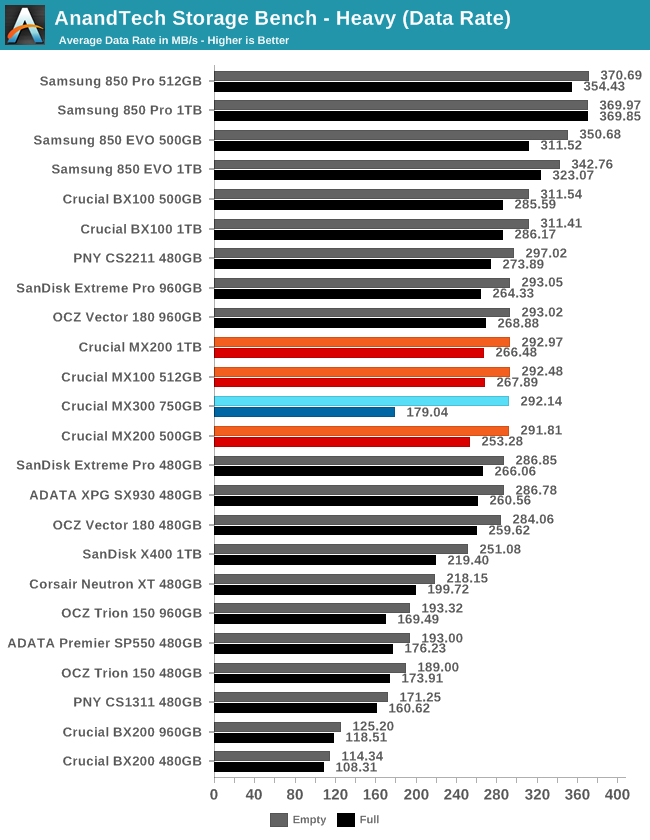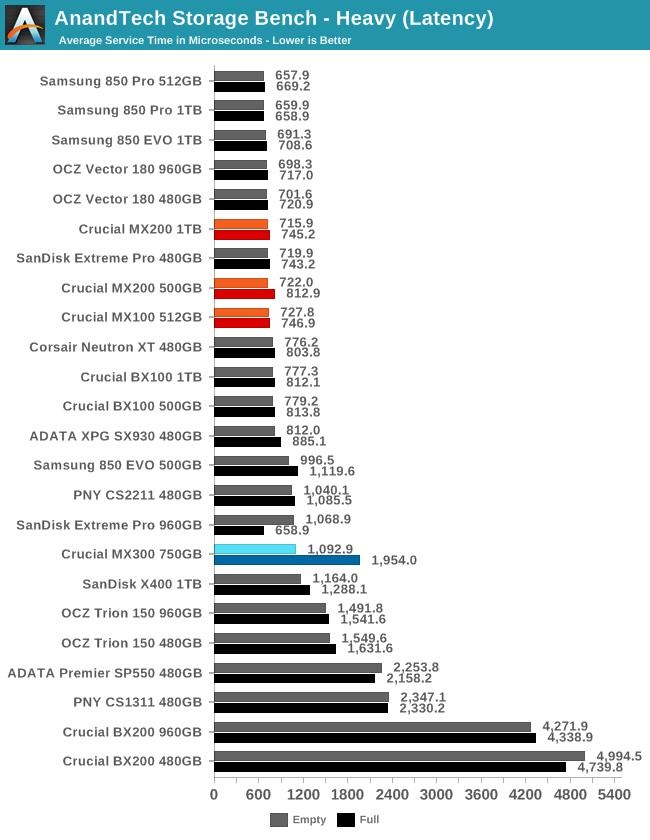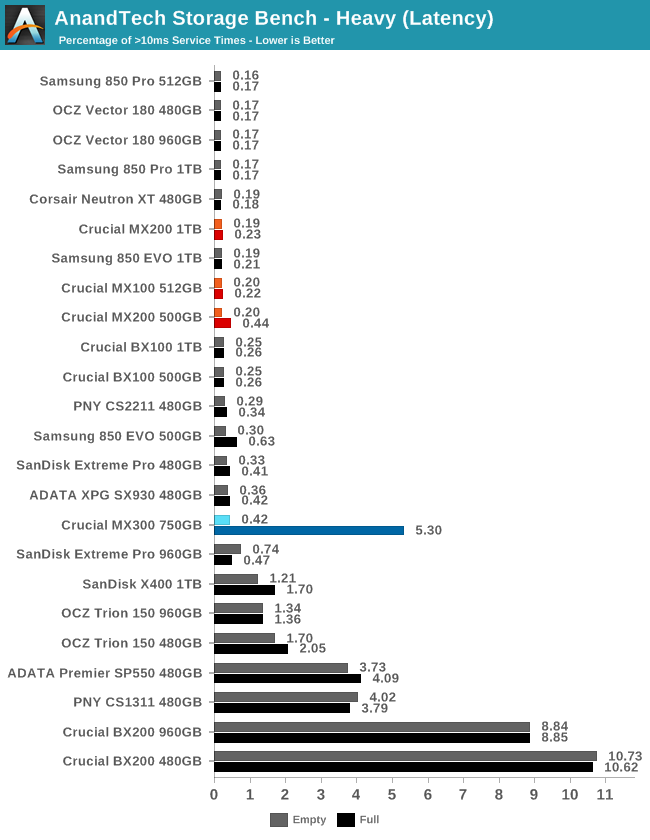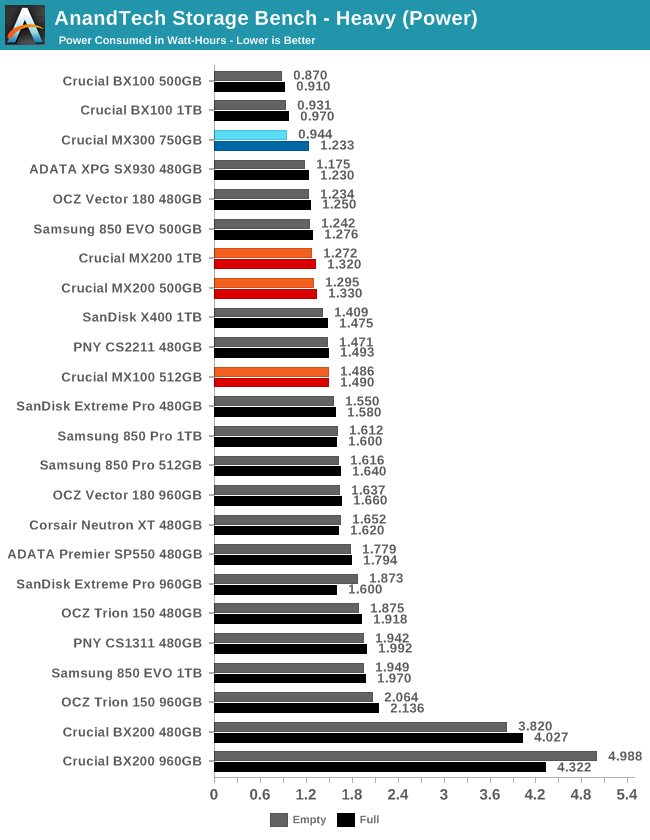The Crucial MX300 750GB SSD Review: Micron's 3D NAND Arrives
by Billy Tallis on June 14, 2016 9:00 AM ESTAnandTech Storage Bench - Heavy
Our Heavy storage benchmark is proportionally more write-heavy than The Destroyer, but much shorter overall. The total writes in the Heavy test aren't enough to fill the drive, so performance never drops down to steady state. This test is far more representative of a power user's day to day usage, and is heavily influenced by the drive's peak performance. The Heavy workload test details can be found here.

The average data rate of the MX300 is virtually identical to that of its predecessors, except that when full the MX300's identity as a TLC drive is revealed by a precipitous drop.

The average service time of the MX300 when running the test on an empty drive places the MX300 between the slow MLC drives and the fast planar TLC. When the test is run on a full drive the average service time grows to be close to that of some of the cheapest drives on the market.

When run on an empty drive, the write-oriented Heavy test doesn't produce a significant number of latency outliers, but on a full drive delays are quite common.

The MX300's power efficiency is once again very close to the top of the charts, even for the full-drive test.










85 Comments
View All Comments
Gondalf - Wednesday, June 15, 2016 - link
Good point. The real story the have not even read the article, or maybe there is a lot of marketing guys at work here.After all Samsung has shipped for two years 3D SSD drivers in nearly money loss cause the low yields of their manufacturing process on a 3D structure.
icrf - Tuesday, June 14, 2016 - link
What is the expected performance of the 3D MLC NVMe SSD, or is that too many variables different to tell from here? I'm curious if the charge trap/floating gate decision affected performance.jabber - Tuesday, June 14, 2016 - link
I'm taking it that Crucial have given up on SSD R&D? After all each Crucial SSD post BX100 (what a great SSD) just gets slower than the previous.JoeyJoJo123 - Tuesday, June 14, 2016 - link
If Crucial has "given up" then what does that speak for Toshiba and other manufacturers that STILL haven't done 3D stacked MLC NAND?Samsung led the innovation 2 years ago and now their first competitor just showed up.
vladx - Tuesday, June 14, 2016 - link
Sandisk X400 seems to be the king of budget SSDs, paying 80USD more for 850 EVO is definitely not worth it imo.Meteor2 - Tuesday, June 14, 2016 - link
Can't dispute that.Lolimaster - Saturday, June 18, 2016 - link
They're not.Unless you move tons of data per day with more than 1 pci-e nvme drive there's no difference between sata and pcie ssd's. PCie ssd uses more power and produces more heat.
Communism - Tuesday, June 14, 2016 - link
With the advent of PCIE 3.0 X4 NAND drives a while ago, the whole SATAIII segment of SSDs are essentially obsolete. The lack of significant competition in the PCIE3.0 X4 NAND drives bringing down prices quickly is disconcerting.The only COGS difference between PCIE3.0 X4 NAND drives and SATAIII drives is the controller, which doesn't actually cost much at all.
Buying into SATAIII SSDs at this point in time simply is a bad idea comparatively.
TheinsanegamerN - Tuesday, June 14, 2016 - link
Sara is hardly obsolete. Pcie m2 drives still only hit 512gb vs the 2tb sata drives, still run hotter, and don't offer much but a faster boot time. Day to day performance between sata and pice is nil unless you are moving hundreds of gigs of data per day onto/off of the drive.Until m.2 is cheaper, cooler, and the same capacity as sata, sata isn't going anywhere.
vladx - Tuesday, June 14, 2016 - link
Actually, NVMe drives boot slower because of additional drivers needed to be loaded.